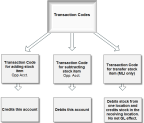Planning Inventory Transaction Codes
Transaction Codes control which General Ledger accounts are affected by adjustment transactions, which will be reflected in your financial statements.
There are two basic adjustment transaction types: additions and subtractions. If you have Multi-Location Inventory installed, you will also have transfers. You need at least one Transaction Code for additions, one for subtractions, and one for transfers (if applicable).
When you create Transaction Codes, use one of these prefix numbers to define how the system should handle the transaction:
• 1 = Add Inventory Quantity
• 2 = Subtract Inventory Quantity
• 3 = Transfer Inventory Quantity (MLI Only)
You can then add a suffix of up to five characters to create a more specific Transaction Code.
To determine how many Transaction Codes to set up, consider how you want adjustments reflected in your general ledger and make a list of the different types of additions and subtractions you might enter. You should add additional Transaction Codes for different types of addition and subtraction adjustments.
For example, let’s say you want to create different Codes for different types of subtraction transactions because you want to direct these adjustments to different General Ledger accounts. Here are a few examples of different types of subtractions:
• Breakage
• Theft
• Charitable Contributions
• Floor Samples
Maybe you want breakage and theft adjustments to affect a different General Ledger account than an adjustment made for a charitable contribution. In this case, you could create a Transaction Code such as 2LOSS to use for adjustments made due to breakage and theft. You could create another Code, such as 2CHAR, for adjustments made because of charitable contributions.
Build a Transaction Code for every combination of accounts for each transaction type.

Click thumbnail to view larger image.
You can add additional codes at any time, but they will only affect future transactions and not previously posted transactions.
Published date: 12/21/2020